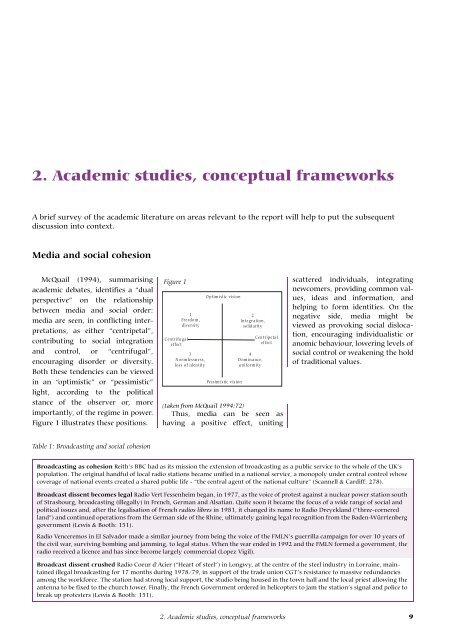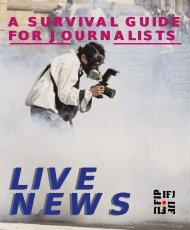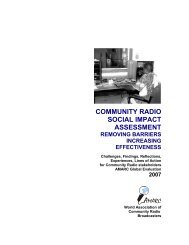Promoting social cohesion: the role of community media - amarc
Promoting social cohesion: the role of community media - amarc
Promoting social cohesion: the role of community media - amarc
- No tags were found...
Create successful ePaper yourself
Turn your PDF publications into a flip-book with our unique Google optimized e-Paper software.
2. Academic studies, conceptual frameworksA brief survey <strong>of</strong> <strong>the</strong> academic literature on areas relevant to <strong>the</strong> report will help to put <strong>the</strong> subsequentdiscussion into context.Media and <strong>social</strong> <strong>cohesion</strong>McQuail (1994), summarisingacademic debates, identifies a “dualperspective” on <strong>the</strong> relationshipbetween <strong>media</strong> and <strong>social</strong> order:<strong>media</strong> are seen, in conflicting interpretations,as ei<strong>the</strong>r “centripetal”,contributing to <strong>social</strong> integrationand control, or “centrifugal”,encouraging disorder or diversity.Both <strong>the</strong>se tendencies can be viewedin an “optimistic” or “pessimistic”light, according to <strong>the</strong> politicalstance <strong>of</strong> <strong>the</strong> observer or, moreimportantly, <strong>of</strong> <strong>the</strong> regime in power.Figure 1 illustrates <strong>the</strong>se positions.Figure 1Centrifu galeffect1Freedom ,diversity3Norm lessness,loss <strong>of</strong> iden tityO ptim istic visionPessim istic vision2Integration,solidarity4D om inance,u niform ityCentripeta leffect(taken from McQuail 1994:72)Thus, <strong>media</strong> can be seen ashaving a positive effect, unitingscattered individuals, integratingnewcomers, providing common values,ideas and information, andhelping to form identities. On <strong>the</strong>negative side, <strong>media</strong> might beviewed as provoking <strong>social</strong> dislocation,encouraging individualistic oranomic behaviour, lowering levels <strong>of</strong><strong>social</strong> control or weakening <strong>the</strong> hold<strong>of</strong> traditional values.Table 1: Broadcasting and <strong>social</strong> <strong>cohesion</strong>Broadcasting as <strong>cohesion</strong> Reith’s BBC had as its mission <strong>the</strong> extension <strong>of</strong> broadcasting as a public service to <strong>the</strong> whole <strong>of</strong> <strong>the</strong> UK’spopulation. The original handful <strong>of</strong> local radio stations became unified in a national service, a monopoly under central control whosecoverage <strong>of</strong> national events created a shared public life - “<strong>the</strong> central agent <strong>of</strong> <strong>the</strong> national culture” (Scannell & Cardiff: 278).Broadcast dissent becomes legal Radio Vert Fessenheim began, in 1977, as <strong>the</strong> voice <strong>of</strong> protest against a nuclear power station south<strong>of</strong> Strasbourg, broadcasting (illegally) in French, German and Alsatian. Quite soon it became <strong>the</strong> focus <strong>of</strong> a wide range <strong>of</strong> <strong>social</strong> andpolitical issues and, after <strong>the</strong> legalisation <strong>of</strong> French radios libres in 1981, it changed its name to Radio Dreyekland (“three-corneredland”) and continued operations from <strong>the</strong> German side <strong>of</strong> <strong>the</strong> Rhine, ultimately gaining legal recognition from <strong>the</strong> Baden-Würrtenberggovernment (Lewis & Booth: 151).Radio Venceremos in El Salvador made a similar journey from being <strong>the</strong> voice <strong>of</strong> <strong>the</strong> FMLN’s guerrilla campaign for over 10 years <strong>of</strong><strong>the</strong> civil war, surviving bombing and jamming, to legal status. When <strong>the</strong> war ended in 1992 and <strong>the</strong> FMLN formed a government, <strong>the</strong>radio received a licence and has since become largely commercial (Lopez Vigil).Broadcast dissent crushed Radio Coeur d’Acier (“Heart <strong>of</strong> steel”) in Longwy, at <strong>the</strong> centre <strong>of</strong> <strong>the</strong> steel industry in Lorraine, maintainedillegal broadcasting for 17 months during 1978/79, in support <strong>of</strong> <strong>the</strong> trade union CGT’s resistance to massive redundanciesamong <strong>the</strong> workforce. The station had strong local support, <strong>the</strong> studio being housed in <strong>the</strong> town hall and <strong>the</strong> local priest allowing <strong>the</strong>antenna to be fixed to <strong>the</strong> church tower. Finally, <strong>the</strong> French Government ordered in helicopters to jam <strong>the</strong> station’s signal and police tobreak up protesters (Lewis & Booth: 151).2. Academic studies, conceptual frameworks 9
















